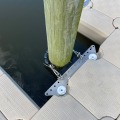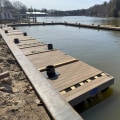Piling installation is an integral part of Dock Construction near Ravenel SC. It involves the insertion of sturdy, vertical piles into the ground to create a solid foundation for the dock. This process may seem simple, but it requires careful planning and execution to ensure a successful and long-lasting result. In this comprehensive guide, we will delve into the intricacies of piling installation for Dock Construction near Ravenel SC, covering everything from the purpose and benefits of piling to the different methods and materials used.
Whether you are a dock builder, property owner, or simply curious about the process, this article will provide you with valuable insights and information. So, let's dive into the world of piling installation and discover how it plays a crucial role in the construction of sturdy and durable docks. Piling installation is a critical step in the dock construction process. It involves driving large wooden or steel poles, known as pilings, into the ground to provide a solid foundation for the dock. These pilings act as support columns, bearing the weight of the dock and any boats or watercraft that may be on it.
There are several factors to consider when installing pilings, such as the type of soil, water depth, and environmental conditions. For example, if the soil is too soft or unstable, additional support may be needed for the pilings. The water depth also plays a significant role in determining the length of the pilings. Deeper waters require longer pilings to ensure stability.
Finally, environmental conditions, such as tides and currents, must also be taken into account when installing pilings. When it comes to the type of soil, there are two main types that are commonly found when building docks: soft soil and hard soil. Soft soil is made up of loose materials such as sand or silt and can shift easily, making it less stable for pilings. Hard soil, on the other hand, is more compact and provides a stronger base for pilings. Another important consideration is the water depth.
The deeper the water, the longer the pilings need to be to ensure stability. This is because the longer pilings will reach further into the ground and provide a more secure foundation for the dock. In addition to soil and water depth, environmental conditions must also be taken into account during piling installation. Tides and currents can significantly impact the stability of a dock and its pilings.
For example, strong currents can put added pressure on the pilings, making them more susceptible to damage. It is essential to consult with a professional before beginning any piling installation for a dock. They will be able to assess the soil, water depth, and environmental conditions to determine the best approach for installing pilings. They can also provide guidance on additional support that may be needed for the pilings, depending on the specific conditions of the location. In conclusion, piling installation is a crucial step in the dock construction process.
It requires careful consideration of factors such as soil type, water depth, and environmental conditions to ensure a stable and durable foundation for the dock. By consulting with a professional and following proper installation techniques, you can ensure a safe and secure dock for years to come.
Maintenance and Repair
Proper maintenance is essential for ensuring the longevity of your dock. Regularly inspecting and repairing any damaged or deteriorating pilings is crucial in preventing further damage. Common issues with pilings include rotting, cracking, or shifting due to environmental factors or marine life.Cost and Materials
The cost of piling installation can vary depending on the type of pile, length, and method of installation.On average, wooden pilings can cost between $500-$1,500 per piling, while steel pilings can cost anywhere from $1,000-$2,500 per piling. The materials needed for piling installation include the piles themselves, a pile driver (if not renting), cables or chains (for floating docks), and any additional support materials (if necessary).
Design Considerations
When it comes to piling installation, there are a few design considerations to keep in mind. Firstly, the spacing between pilings is crucial for the stability of the dock. The general rule of thumb is to space pilings no more than 8 feet apart. Additionally, the angle at which the pilings are driven also affects stability.It is recommended to drive pilings at a slight angle towards the center of the dock to provide better support.
Types of Piles
When it comes to piling installation for dock building, there are two main types of piles that are commonly used: wooden and steel. Each type has its own unique properties and benefits, and the choice between the two will depend on the specific needs and requirements of your dock project. Wooden piles are typically made from treated timber, such as pine or cedar. This is because these types of wood are able to withstand the harsh conditions of being in constant contact with water and exposed to various weather elements. Treated wood is also resistant to rot and decay, making it a durable option for piling installation. On the other hand, steel piles are known for their strength and durability.They are able to support larger and heavier docks, making them a great choice for projects that require a strong foundation. However, steel piles are also more expensive than wooden piles, so it is important to consider your budget when deciding which type of pile to use.
Floating Docks
For those looking for a more versatile option, floating docks may be the way to go. These docks are not anchored to the ground and instead rely on flotation devices, such as barrels or pontoons, to keep them afloat. Piling installation for floating docks involves securing the pilings to the bottom of the water body using cables or chains.This allows the dock to move with the water level, making it ideal for areas with varying water depths.
Pile Driving Techniques
When it comes to piling installation for dock building, it's important to understand the different techniques used for driving piles. The two primary methods are impact driving and vibratory driving. Impact driving involves using a large hammer to drive the pile into the ground. This method is best suited for dense soils and is typically used for steel piles. It provides a strong and stable foundation for the dock, making it a popular choice for many builders. Vibratory driving, on the other hand, uses a vibrating pile driver to push the pile into the ground.This method is better for softer soils and is commonly used for wooden piles. The vibrations help to loosen the soil, allowing the pile to be inserted more easily. It's important to choose the right method for your specific soil conditions to ensure a successful piling installation. Consulting with a professional dock builder can help you determine which technique is best for your project. Piling installation is a crucial step in building a sturdy and durable dock. By understanding the different types of piles, methods of driving, design considerations, and maintenance techniques, you can ensure the longevity of your dock.
Additionally, considering floating docks as an option may provide more versatility for your needs. Remember to factor in the cost of materials and installation when planning your dock construction.






